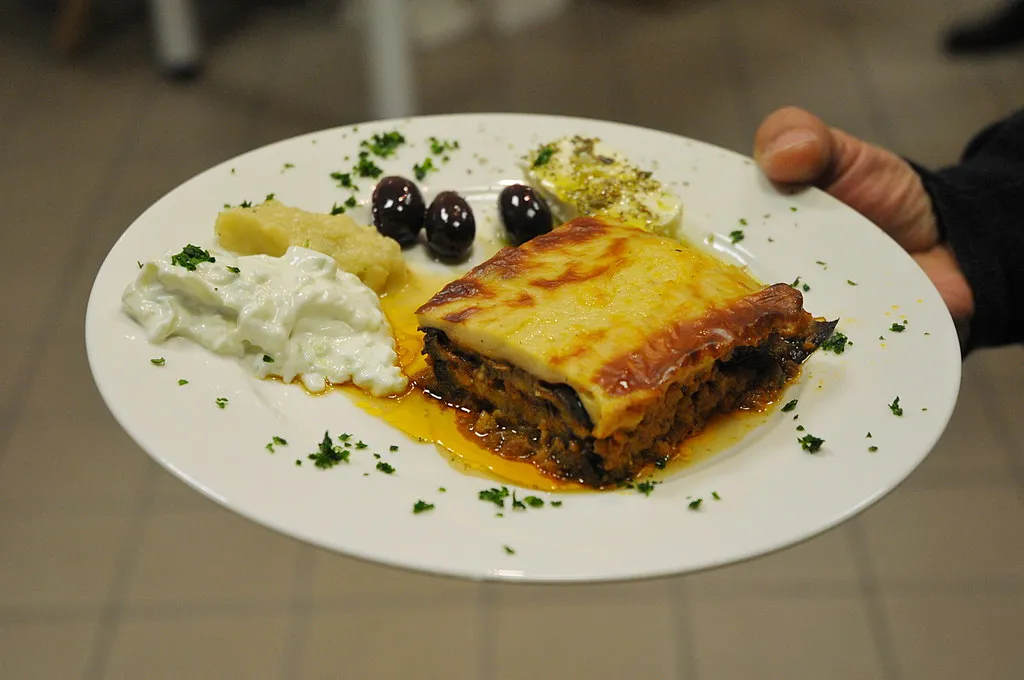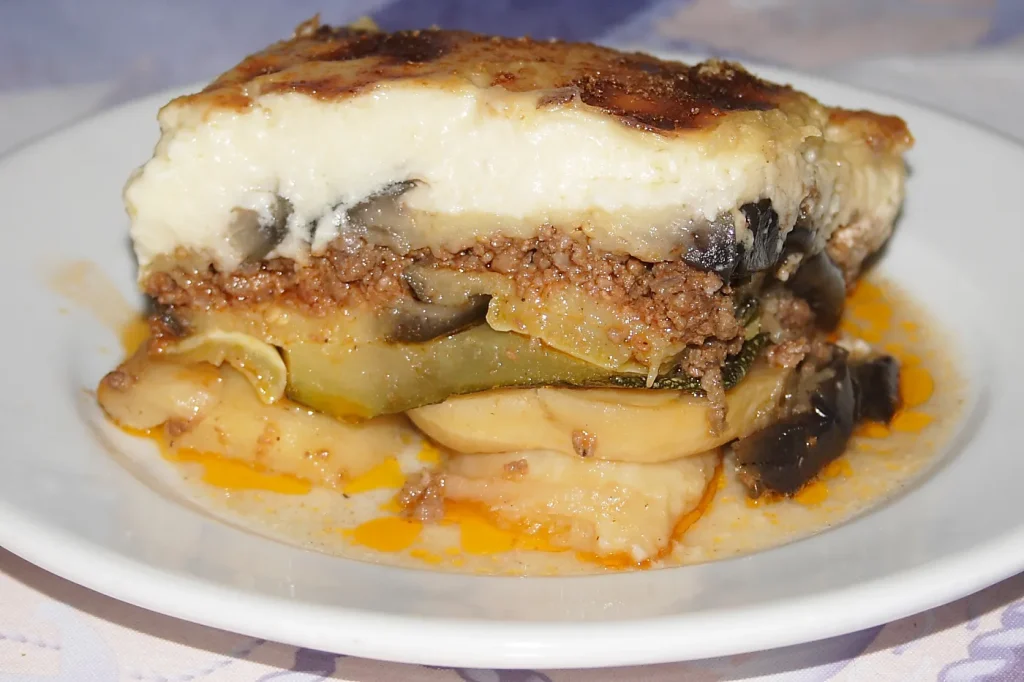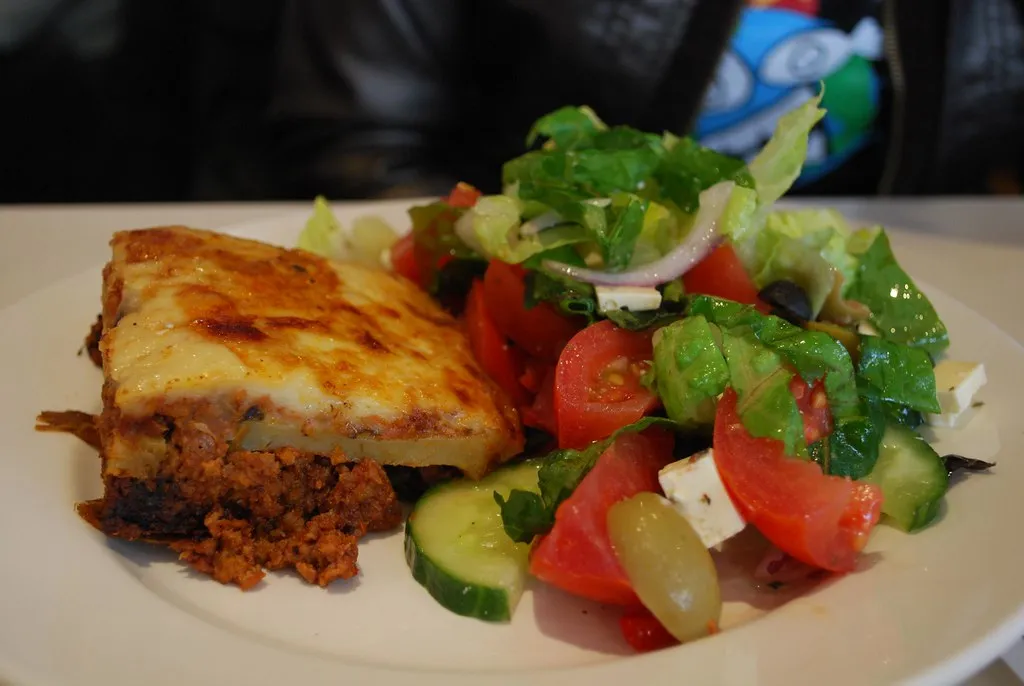The Best Fluffy Pancakes recipe you will fall in love with. Full of tips and tricks to help you make the best pancakes.
Persian Moussaka is a delicious, comforting dish that brings the rich flavors of Persian cuisine to your table. A savory casserole made with tender eggplant, aromatic spices, and a hearty meat filling, it’s a perfect blend of Middle Eastern and Mediterranean influences. This beloved dish is often enjoyed as a family meal or for special occasions, offering a satisfying and flavorful experience. The beauty of Persian Moussaka lies in its simplicity and the ability to elevate everyday ingredients like eggplant and ground meat into a dish full of depth and warmth. Whether you’re new to Persian cooking or a seasoned foodie, learning how to make Persian Moussaka at home will add a delicious new recipe to your collection. Let’s dive into the steps, tips, and secrets to preparing this hearty meat and eggplant dish!
What is Persian Moussaka?
Persian Moussaka is a flavorful and hearty dish that embodies the essence of Persian cuisine. A comforting casserole, it combines layers of eggplant, ground meat (typically beef or lamb), tomatoes, and a rich blend of aromatic spices. This Persian version of moussaka is a delightful variation of the Mediterranean classic, offering a distinctive twist with its use of Persian spices like saffron and cinnamon. While sharing similarities with other regional moussaka recipes, Persian Moussaka is unique in its deep, fragrant flavors, making it a beloved dish in Iran and across the Middle East.

The Origins of Moussaka
Moussaka is widely recognized throughout the Mediterranean and the Middle East, but the Persian variation has its own unique history. The dish likely evolved over time, influenced by Persian culinary traditions and local ingredients. While Greek and Ottoman versions are more well-known internationally, the Persian take on moussaka is distinguished by the use of Persian spices and techniques, which add richness and complexity to the dish.
- A Mediterranean Legacy
The Mediterranean moussaka has roots in the Ottoman Empire, which influenced many regional cuisines, including Persian. Over time, Persian chefs adapted the dish to fit the available ingredients and regional tastes, incorporating a mix of bold, fragrant spices and tender eggplant to create their own signature version. - A Special Occasion Dish
In Persian culture, moussaka is often prepared for family gatherings, holidays, or special events. The dish’s rich flavors and hearty nature make it an ideal choice for celebrations, bringing people together around the table to enjoy its delicious layers.
The Key Ingredients in Persian Moussaka
The magic of Persian Moussaka lies in its carefully selected ingredients, which work together to create a balanced, comforting meal. Here’s a closer look at the core ingredients:
- Eggplant
Eggplant is the star of the dish, providing a meaty texture that absorbs the flavors of the spices and meat. Traditionally, the eggplant is sliced and either grilled or fried, which enhances its flavor and tenderness. The eggplant forms the base layer in the casserole, soaking up the rich juices from the meat and spices. - Ground Meat (Beef or Lamb)
While ground beef is often used as a more accessible option, lamb is the traditional choice for Persian Moussaka. Lamb brings a distinctive flavor that pairs beautifully with the spices used in the dish. The ground meat is sautéed with onions, garlic, and spices, creating a savory filling that contrasts perfectly with the soft eggplant layers. - Persian Spices
The unique flavor of Persian Moussaka comes from the careful combination of spices like saffron, cinnamon, turmeric, and sometimes cumin. These spices infuse the meat and eggplant with complex flavors, creating a dish that’s aromatic and deeply satisfying. Saffron, in particular, adds a golden hue and subtle floral notes, making the dish feel luxurious and rich. - Tomatoes and Yogurt
Tomatoes are added to the meat mixture, contributing a touch of acidity and sweetness to balance the richness of the dish. Some variations include yogurt, either in the meat filling or as a creamy topping, which provides a tangy contrast and enhances the overall creaminess of the casserole.
Why Persian Moussaka is a Comforting Dish
Persian Moussaka is considered a comforting, heartwarming dish in Iranian households. Its hearty ingredients and rich layers create a sense of fullness and satisfaction, making it ideal for family meals or special occasions. The blend of savory meat, tender eggplant, and aromatic spices offers a taste of Persian home-cooking, and the dish is often served with fluffy Persian rice or warm flatbreads to soak up all the flavors.
- The Layering Process
What makes Persian Moussaka so special is the layering technique, where each ingredient is carefully placed to ensure the right balance of flavors in every bite. The combination of tender eggplant, spiced meat, and tomato creates a harmonious layering of textures and tastes, resulting in a casserole that’s both comforting and complex. - Perfect for Sharing
Due to its generous portions, Persian Moussaka is perfect for gatherings and celebrations. It’s often shared among family and friends, making it a staple in Persian hospitality. Whether served at a festive meal or as a comforting weeknight dinner, this dish has a way of bringing people together.
How to Prepare the Perfect Persian Moussaka
Preparing the perfect Persian Moussaka is a rewarding process that involves several steps to achieve the right balance of flavors and textures. The dish requires layering tender eggplant, savory spiced meat, and a rich tomato mixture, then baking it all to perfection. Follow these steps to ensure that your Persian Moussaka turns out deliciously hearty and full of flavor.

Step 1: Preparing the Eggplant
Eggplant is the star of the dish, and how it’s prepared makes a significant impact on the final texture and flavor.
- Slicing the Eggplant
Start by slicing the eggplant into rounds, about 1/2 inch thick. Make sure to use firm, fresh eggplants to avoid bitterness and ensure a tender texture once cooked. - Salting the Eggplant
To remove any bitterness and excess moisture, sprinkle the eggplant slices with salt and let them sit for about 30 minutes. Afterward, rinse off the salt and pat the slices dry with a paper towel. This step helps the eggplant cook more evenly and prevents it from becoming soggy. - Frying or Grilling the Eggplant
You can either fry or grill the eggplant slices. Frying in oil gives the eggplant a crispy texture on the outside, while grilling provides a smokier flavor. Both methods work well, so the choice depends on your preference. When frying, cook each slice until golden and tender, and when grilling, achieve grill marks and a slightly charred flavor. Set the cooked eggplant aside to cool.
Step 2: Cooking the Meat Mixture
The meat mixture is where the deep, savory flavors of Persian Moussaka come from. The ground meat is seasoned with aromatic spices and combined with onions and tomatoes to create a flavorful filling.
- Sautéing Onions and Garlic
In a large skillet, heat some oil over medium heat. Add finely chopped onions and garlic, and sauté until soft and fragrant, about 5-7 minutes. The caramelized onions add sweetness and depth to the dish. - Cooking the Ground Meat
Add the ground meat (beef or lamb) to the skillet, breaking it apart with a spoon. Cook the meat until browned and cooked through. For a more authentic flavor, use lamb, as it pairs beautifully with the spices in the recipe. - Seasoning the Meat
Once the meat is browned, add your Persian spices: turmeric, cinnamon, saffron, and a pinch of cumin. These spices give the moussaka its signature warm, aromatic flavor. Stir in chopped tomatoes or tomato paste, and cook the mixture until the tomatoes soften and create a rich sauce. Let the meat mixture simmer for about 10-15 minutes to allow the flavors to meld together. Season with salt and pepper to taste.
Step 3: Assembling the Layers
The beauty of Persian Moussaka is in its layers. Proper layering ensures that each bite is balanced, with the tender eggplant, spiced meat, and rich sauce working together harmoniously.
- Layering the Eggplant and Meat Mixture
In a large baking dish, start by placing a layer of the cooked eggplant slices on the bottom. Follow with a layer of the spiced meat mixture, spreading it evenly. Repeat this process, layering the eggplant and meat until all ingredients are used. For the final layer, top with a few extra slices of eggplant to create a beautiful, uniform top.- If you’re looking for the perfect baking dish for this recipe, you can find a great Ninja Casserole Dish on Amazon that’s perfect for baking Moussaka. It’s a medium-sized dish that can handle the layers of eggplant and meat with ease.
- Adding a Creamy Topping (Optional)
Some variations of Persian Moussaka include a creamy yogurt topping. For this, mix plain yogurt with a little bit of egg, salt, and a dash of turmeric. Spread the yogurt mixture over the top layer of eggplant to create a creamy, golden crust when baked. If you prefer a more traditional approach, you can skip this step and bake the dish without the yogurt topping.
Step 4: Baking the Persian Moussaka
Baking the assembled moussaka allows all the flavors to meld together, creating a cohesive and hearty dish.
- Baking Time and Temperature
Preheat your oven to 350°F (175°C). Place the baking dish in the oven and bake for about 45-60 minutes, or until the top is golden brown and the dish is bubbling. The eggplant should be tender, and the flavors of the meat and spices should be fully developed. - Letting It Rest
Once the moussaka is done, allow it to rest for 10-15 minutes before serving. This resting time helps the layers settle and makes the dish easier to cut into neat slices.
Step 5: Serving the Perfect Persian Moussaka
Now that your moussaka is ready, it’s time to serve and enjoy!
- Garnishing and Accompaniments
Persian Moussaka is typically served with Persian rice (like saffron rice) or warm flatbread, which is perfect for soaking up all the flavorful juices. You can also garnish the moussaka with fresh herbs like parsley or mint for a fresh contrast to the rich, savory flavors. - Serving Suggestions
For a complete meal, serve Persian Moussaka with a side of Persian Salad Shirazi (a refreshing cucumber and tomato salad) or pickles (torshi). These side dishes complement the richness of the moussaka and add a refreshing touch to the meal.
The Essential Spices and Ingredients for Persian Moussaka
Persian Moussaka relies on a unique blend of spices and fresh ingredients that create the dish’s signature depth of flavor. Understanding the key components used in the recipe will help you achieve the authentic taste that this beloved dish is known for. The combination of fresh vegetables, tender meat, and aromatic spices comes together to create a mouthwatering meal.
Key Ingredients in Persian Moussaka
While the ingredients can vary slightly, there are some essentials that form the base of any good Persian Moussaka recipe.
Eggplant (Aubergine)
Eggplant is the star ingredient in this dish. It forms the bulk of the casserole, creating the tender base layer that absorbs all the savory meat sauce. The eggplant should be sliced into thin rounds, salted, and either fried or grilled for the best results. Fresh, firm eggplants are best as they hold up well during cooking and offer the right texture.
Ground Meat
Traditionally, Persian Moussaka uses ground lamb, though ground beef is also commonly used. Lamb provides a rich and slightly gamey flavor that pairs perfectly with the spices. The meat is browned and then simmered with spices to create a hearty, flavorful filling. If you prefer a leaner option, ground turkey or chicken can be used, but the dish may lack the same richness.
Tomatoes
Fresh tomatoes or tomato paste are essential to the dish’s flavor profile. The tomatoes provide the tangy, slightly sweet base that complements the richness of the ground meat and eggplant. When using fresh tomatoes, they should be chopped finely to create a smooth sauce with the meat. Tomato paste thickens the sauce and enhances the savory depth of the dish.
Yogurt (Optional Topping)
In some variations of Persian Moussaka, a creamy yogurt topping is added for richness and tang. This mixture of plain yogurt, egg, and a pinch of turmeric creates a beautiful golden topping when baked. While optional, it adds an extra layer of flavor and a smooth texture that contrasts with the savory filling.
Essential Spices in Persian Moussaka
The unique flavor of Persian Moussaka comes from the careful combination of spices. These spices are common in Persian cuisine and add warmth, depth, and complexity to the dish.
Turmeric
Turmeric is one of the most essential spices in Persian Moussaka. It provides a warm, earthy flavor and a golden color that enhances the overall appearance of the dish. This spice is not only aromatic but also has anti-inflammatory properties that contribute to the health benefits of the dish.
Saffron
Saffron is another quintessential Persian spice, offering both color and flavor. It adds a subtle floral and slightly sweet taste to the moussaka. Saffron should be used sparingly, as its flavor is quite potent. Typically, a small amount of saffron threads is steeped in hot water to release its color and aroma, which is then added to the meat mixture.
Cinnamon
Cinnamon introduces a sweet, warm flavor that complements the savory meat and vegetables. In Persian cuisine, cinnamon is often used in savory dishes like stews and casseroles, giving them a fragrant and comforting aroma. A dash of cinnamon in the meat sauce balances the richness of the lamb and adds a nuanced depth of flavor.
Cumin
Cumin adds a smoky, slightly nutty taste to the dish. Its warm and earthy profile enhances the savory elements of the moussaka, working in harmony with the turmeric and cinnamon. Cumin should be used carefully to avoid overpowering the dish, but it’s essential for achieving the authentic Persian flavor.
Black Pepper
Black pepper is another staple that brings a hint of heat and spiciness to the moussaka. While not as prominent as other spices, it balances out the rich flavors of the meat and complements the earthy spices like cumin and cinnamon.
Optional Ingredients for Extra Flavor
While the core ingredients and spices make the dish, there are some optional ingredients that can elevate the Persian Moussaka to another level.
Garlic
Garlic is an aromatic ingredient that adds depth and a savory punch to the meat mixture. Whether sautéed with onions or added directly to the meat sauce, garlic enhances the overall flavor profile of the dish and contributes to its complexity.
Onions
Onions are a key ingredient in many Persian dishes, and in Moussaka, they provide sweetness and richness. Sautéing onions until they are golden and soft brings out their natural sugars, which adds to the base flavor of the meat sauce.
Fresh Herbs
Fresh herbs like parsley, mint, or basil can be sprinkled on top of the dish after it’s baked or incorporated into the meat mixture. These herbs add a burst of freshness and a touch of color to the moussaka. Parsley is particularly common in Persian dishes, while mint adds a refreshing, cooling contrast to the richness of the eggplant and meat.
Lemon Juice
A splash of fresh lemon juice can brighten up the dish, especially if it’s served with a side salad or as part of a larger meal. The acidity of the lemon helps balance the richness of the moussaka, making it feel less heavy.
Tips and Variations for Making Persian Moussaka
Persian Moussaka is a comforting, hearty dish that benefits from thoughtful preparation and careful attention to the right ingredients and techniques. Here are some essential tips for perfecting your Moussaka, as well as creative variations you can try to make it your own.

Tips for Perfecting Your Persian Moussaka
To ensure your Persian Moussaka turns out perfectly every time, follow these tried-and-true tips that will elevate your dish.
Use Fresh and Firm Eggplants
Eggplants are the star of Persian Moussaka, and selecting the right ones is key. Choose fresh, firm eggplants with smooth, shiny skin. Avoid those that are overly soft or have blemishes, as they can have a bitter taste and mushy texture when cooked. Fresh eggplants will give your Moussaka the perfect texture—tender, but not too soggy.
Salt the Eggplant to Remove Bitterness
Eggplants can sometimes have a slightly bitter taste, so salting them helps to draw out moisture and bitterness. Slice your eggplants, sprinkle them with salt, and let them sit for about 20–30 minutes. Afterward, rinse off the salt and pat the slices dry with a paper towel to prevent the dish from becoming too watery.
Cook the Eggplant Properly
Eggplant can be cooked in various ways, but the most common methods are frying or grilling. Frying gives the eggplant a crispy exterior, but grilling or roasting is a healthier alternative. Grilling also adds a smoky flavor to the Moussaka, which enhances the dish’s depth. Regardless of the method, ensure the eggplant is cooked thoroughly before layering it in the dish.
Rest the Moussaka Before Serving
After baking your Persian Moussaka, allow it to rest for 15–20 minutes before serving. This helps the layers set, making it easier to cut and serve. Resting also allows the flavors to meld together and intensify, resulting in a more flavorful dish.
Variations to Try with Persian Moussaka
While the traditional recipe for Persian Moussaka is already delicious, you can try these variations to create a dish that’s uniquely yours or to accommodate specific dietary needs.
Vegetarian or Vegan Persian Moussaka
For a plant-based version of this dish, swap out the ground meat for alternatives like lentils, quinoa, or mushrooms. These ingredients mimic the texture and flavor of meat, absorbing the same spices and creating a hearty filling. To make it vegan, replace the yogurt topping with a plant-based alternative, such as coconut yogurt or cashew cream. For a great vegan Moussaka recipe, check out this detailed guide on Rainbow Plant Life.
Add Potatoes for Extra Heartiness
For a more substantial meal, try adding thin layers of potatoes between the eggplant and meat. Potatoes are an excellent way to bulk up the dish and add a creamy, soft texture. They can be sliced thinly and sautéed or roasted before layering them into the Moussaka. This variation is especially satisfying during the colder months when you’re craving a heartier dish.
Incorporate Pomegranate Molasses for Tanginess
Pomegranate molasses is a signature ingredient in Persian cuisine and adds a wonderful tangy sweetness to savory dishes. Try adding a tablespoon of pomegranate molasses to the meat sauce. It pairs beautifully with the spiced ground meat, enhancing the dish with a slightly sweet, tart flavor that complements the richness of the eggplant.
Grilled or Roasted Eggplant Instead of Fried
For a lighter version of Persian Moussaka, consider roasting or grilling the eggplant instead of frying. Grilling adds a smoky flavor, while roasting enhances the natural sweetness of the eggplant. Both methods reduce the amount of oil needed, making the dish a bit healthier without sacrificing flavor or texture.
Cheese Lovers’ Persian Moussaka
If you love cheese, consider adding a cheesy layer to your Moussaka. Adding a layer of mozzarella, feta, or a mix of Persian cheeses like Kashk or Panir will elevate the dish with a creamy, melty texture. The cheese adds richness and works well with the savory meat and eggplant layers, creating a luxurious finish.
Serving Suggestions and Accompaniments
Persian Moussaka is often enjoyed with a variety of sides that complement its rich and hearty flavors.
Pair with Shirazi Salad
A crisp and refreshing Shirazi salad is the perfect accompaniment to Persian Moussaka. Made with diced cucumbers, tomatoes, onions, and a lemony dressing, the salad adds a fresh, tangy contrast to the richness of the Moussaka.
Serve with Persian Flatbreads
Serve your Moussaka with warm, soft Persian flatbreads like lavash or sangak. These breads are perfect for scooping up the flavorful filling and soaking up the savory sauce. Persian bread is an integral part of the meal, enhancing the overall experience.
Add Torshi (Pickled Vegetables)
Torshi, a type of Persian pickled vegetable, is often served alongside Moussaka. The sharp acidity of pickled cucumbers, eggplant, or cauliflower balances out the rich and savory flavors of the Moussaka. Torshi adds a refreshing crunch and tang that enhances the dish’s overall taste.





